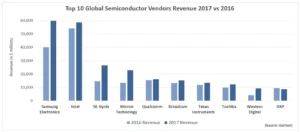Driven by strong growth in the memory market, worldwide semiconductor revenue totaled $420.4 billion in 2017, a 21.6% increase from 2016 revenue of $345.9 billion, according to final results by Gartner. Research director George Brocklehurst commented:
“2017 saw two semiconductor industry milestones—revenue surpassed $400 billion and Intel, the number-one vendor for the last 25 years, was pushed into second place by Samsung Electronics. Both milestones happened due to rapid growth in the memory market as undersupply drove pricing for DRAM and NAND flash higher”.
The memory market surged nearly $50 billion to reach $130 billion in 2017, a 61.8% increase from 2016. Samsung’s memory revenue alone increased nearly $20 billion in 2017, moving the company into the top spot in 2017. However, Gartner predicts that the company’s lead will be short-lived and will disappear when the memory market goes into its bust cycle, most likely in late 2019.
![]()
The booming memory segment overshadowed strong growth in other categories in 2017. Non-memory semiconductors grew $24.8 billion to reach $290 billion, representing a growth rate of 9.3%. Many of the broadline suppliers in the top 25 semiconductor vendors, including Texas Instruments, STMicroelectronics and Infineon, experienced high growth as two key markets, industrial and automotive, continued double-digit growth, buoyed by broad-based growth across most other end-markets.
The combined revenue of the top 10 semiconductor vendors increased by 30.6% during 2017 and accounted for 58% of the total market, outperforming the rest of the market, which saw a milder 11% revenue increase.
2017 was a slower year for closing mergers and acquisitions with roughly half the deal value and number of deals compared with 2016. However, the semiconductor industry continues to see escalating deal sizes with greater complexity, which are becoming more challenging to close. Avago set a record in its acquisition of Broadcom for $37 billion in 2016 and this record should soon be broken by Qualcomm’s acquisition of NXP Semiconductors for $44 billion.
Growth in the IoT is having a significant impact on the semiconductor market, with application-specific standard products (ASSP) for consumer applications up by 14.3% and industrial ASSPs rising by 19.1% in 2017. Semiconductors for wireless connectivity showed the highest growth with 19.3% in 2017 and topping $10 billion for the first time, despite reduced component prices and the static smartphone industry.
Analyst Comment
At the moment, there are no Chinese companies in the top ten list. However, that is bound to change, over time. Semiconductors currently represent $260 billion (2017) of imports to China – well above the amount spent on oil – and around 14% of all the import value into China, so the government is very keen to boost local production. However, it will need a lot of technology and a lot of engineers to achieve this. Nikkei reports that the Chinese government is trying to attract investment from overseas companies to help get technology into the country. There is an estimate, reported in Japan, that 700,000 engineers and professionals may be needed and there are just 300,000 in the industry at the moment.
The increase in revenues from memory made a sharp impact on Samsung’s revenues. However, prices can fall as well as rise quickly in the memory market. On the other hand, Samsung is a long way ahead of its non-Intel competitors. (BR)

